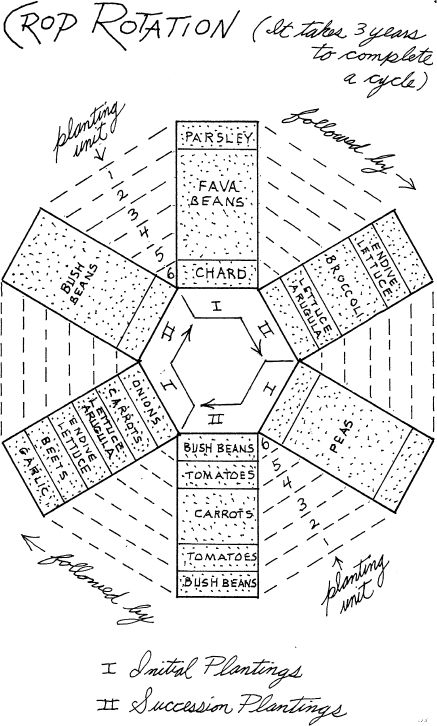
The rotation of crops is based on the fact that different crops draw on different nutrients and each is susceptible to different pests and diseases. By rotating your crops all the nutrients are drawn upon in turn keeping the soil in balance and all pests and soil borne diseases are left without their host crop. A rotation must consider not only the plant itself but also its family and nutrient requirement.
The plants grown fall into the following family groups: Amaryllidaceae: garlic, onion. Chenopodiaceae: beet, Swiss chard. Compositae: endive, lettuce. Cruciferae: arugula, broccoli, radish. Leguminosae: fava beans, bush beans, peas. Solanaceae: tomato. Umbelliferae: carrot, parsley.
They also fall into the following approximate nutrient requirement classifications: Heavy feeders: tomato, broccoli, most leaf vegetables, arugula, endive, lettuce, Swiss chard and parsley. Light feeders: most root crops, carrots, garlic, onions, beets and radishes. Soil improvers: all of the legumes, bush beans, fava beans, peas; their roots bear modules that help fix in the soil the nitrogen present in the atmosphere.
There is no one absolute rule for the rotation of crops that I know of. Some follow heavy feeders with light feeder then legumes. Others vary that sequence, putting legumes after heavy feeders followed by light feeders: Still other rotate according to plant size and rooting depth; or by alternating slow growing crops with rapid growers. It can all get very complicated and awfully confusing. But there are some common threads running through most of these theories, and these common elements are on what I based my rotation system. Generally, crops that have big differences in their feeding requirements should follow one another. In setting up my rotation I kept changing and moving crops around until a practical sequence was arrived at. My final crop rotation system is based on three guidelines:
1) Do not follow a heavy feeder with another heavy feeder. Crops that draw heavily on nutrients if planted in succession will soon deplete the soil, resulting in weak unhealthy plants making them susceptible to insect attacks and creating the poor soil conditions favorable to weeds.
2) Do not follow any crop with another in its family. Since both will draw upon the same nutrients, the soil will quickly become unbalanced. Instead, follow with a member of a different family. Each crop family draws different nutrients and each contributes something different to improving the soil. Note: Legumes are unique in that they will grow quite well in the same spot for several years in a row. But their nitrogen-adding properties make them especially valuable in rotation with other families.
3) A legume must be a component of each crop group. Being “soil improvers” they are vital in a rotation system. They are needed to be inserted between both heavy and light feeders. Besides adding nitrogen, their roots seem to work the soil. They are a major factor in good soil management.
The three separate modules greatly simplifies crop rotation. Since the planting areas are separated, soil is not spread from one plot to another, greatly controlling soil borne diseases and pests. It also permits the organizing of crops into groups which remain constant and fill a complete module. Rotation is achieved by moving the entire crop group into a different module each year. Besides crop rotation, good soil management dictates that the nutrients in the remnants of plants that have been fully harvested be returned to the soil in the form of compost. A regular program of crop rotation, composting and mulching will ensure that the nutrients in the soil remain balanced.
The chart on page 137 shows the exact rotation. By following each planting unit around the cycle it will be seen that aside from bush beans being followed by fava beans, both members of the same family, the guidelines have been adhered to. This was unavoidable because I wanted a legume in each crop group. Anyway, as was mentioned previously, a legume is an exception to the rule and can follow another legume without any negative effects. I believe it to be a valid compromise.
Theoretically, this rotation should minimize the using up of nutrients in the soil, help control the spread of soil borne diseases and disrupt the life cycles of harmful garden pests.
The garden map on pages 72 and 73 shows each crop group in its correct module for the first year. To complete a full rotation cycle the crop groups have to be moved as a unit to a different module at the start of each season.
The crop group in module 1 moves to module 3 and the other two move up one, as follows:
First year
A group is planted in module 1
B group is planted in module 2
C group is planted in module 3
Second year
B group is now planted in module 1
C group is now planted in module 2
A group is now planted in module 3
Third year
C group is now planted in module 1
A group is now planted in module 2
B group is now planted in module 3
Fourth year
All crop groups are back in their original modules.
It takes three years to complete a full cycle.

Note: Besides food crops some gardeners also grow compost crops, such as vetch and rye, specifically to provide organic material for the compost pile.
Those who follow this practice will have to add a fourth module and a compost crop group. Using “D” to denote the compost crop group, the rotation sequence would then be: 1st yr-ABCD: 2nd yr.-BCDA: 3rd yr.-CDAB: 4th yr.-DABC: 5th yr. same as 1st yr. Four years completes a cycle.
